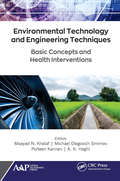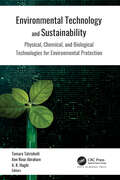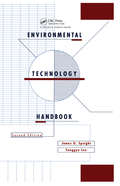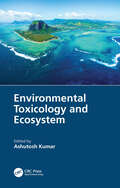- Table View
- List View
Environmental Systems Engineering and Economics
by Robert Willis Brad A. FinneyEnvironmental Systems Engineering and Economics emphasizes the application of optimization, economics, and systems engineering to problems in environmental resources management. This senior level/graduate textbook introduces optimization theory and algorithms that have been successful in resolving water quality and groundwater management problems. Both linear programming and nonlinear optimization are presented. Multiobjective optimization and the linked simulation-optimization (LSO) methodology are also introduced. The basic principles of economics and engineering economics are also discussed to provide a framework for economic decision making. This text contains numerous example problems. Case studies are presented that address water resources management issues in the north China plain, the control of saltwater intrusion in Jakarta, Indonesia, and groundwater resources management in the Yun Lin basin, Taiwan.
Environmental Technologies and Trends: International and Policy Perspectives (Environmental Science and Engineering)
by Ravi K. Jain, Yves Aurelle, Corinne Cabassud, Michel Roustan and Stephen P. SheltonThis manuscript was made possible by the exceptional support provided by INSA (Institut National des Sciences Appliquees) Toulouse, the University of New Mexico and the University of Cincinnati College of Engineering. The authors, as listed in this book, took the time to prepare excellent manuscripts focusing on scientific and technical areas relevant to emerging environmental issues. These manuscripts were rigorously reviewed and refereed by scientists and engineers before inclusion in this book. An introductory chapter was prepared to summarize and integrate technical issues covered and the last chapter was written to present policy perspectives. The editors are most grateful to the contributors, sponsor organizations, and many colleagues who were kind enough to assist us in making this manuscript possible. Background information about the editors, principal authors and other contributor:s to this manuscript follows. Editors Professor Dr. Ravi K. Jain Associate Dean for Research and International Engineering College of Engineering University of Cincinnati Mail Location 0018 Cincinnati OH 45221-0018 U.S.A.
Environmental Technology: Proceedings of the Second European Conference on Environmental Technology, Amsterdam, The Netherlands, June 22–26, 1987
by K. J. A. De Waal W. J. Van Den BrinkFive billion people, at present the world population, inevitably affect the quality of the environment. The general public in an increasing number of countries is getting more and more concerned about this deterioration in quality. As a result many people cast doubts upon the desirability of the increase in energy consumption, the production of superfluous goods, ever-growing waste flows, harmful emissions of industrial processes, and so on. Actually, no one can simply ignore these issues. For instance, the authorities could introduce more environmental legislation aiming at a healthy environment; industries could change to cleaner production processes; the public at large should assume an even more conservation-minded attitude rather than confine themselves to shaking a finger at 'the industry'. In short, in all sectors of society there are often numerous ways and means of curbing environmental pollution. Clearly, environmental technology - the development and application of techniques to identify, quantify and reduce environmental problems - can make a substantial contribution here in many situations. Until now a large number of such new techniques have been developed. Many of these techniques not only appear to add greatly to reducing the burden on the environment, they sometimes also offer interesting economic advantages (savings in raw material and energy, etc.).
Environmental Technology and Engineering Techniques: Basic Concepts and Health Interventions
by Moayad N. KhalafThe crucial interdependence between humans and their environment is explored and illuminated in this revealing overview of the major environmental issues facing society in the twenty-first century. This volume presents a novel picture of some of the current advances in the research of theoretical and practical frameworks of environmental problems and solutions taken from the latest empirical findings.This new volume focuses on the aspects of new techniques that are particularly valuable for solving environmental problems. The complex environmental issues are presented in simple terms to helpreaders grasp the basics and solve relevant problems. Timely and comprehensive discussions of applications to real-world environmental concerns are a central focus of this research-oriented volume.
Environmental Technology and Engineering Techniques: Basic Concepts and Health Interventions
by Moayad N. Khalaf Michael Olegovich Smirnov Porteen Kannan A. K. HaghiThe crucial interdependence between humans and their environment is explored and illuminated in this revealing overview of the major environmental issues facing society in the twenty-first century. This volume presents a novel picture of some of the current advances in the research of theoretical and practical frameworks of environmental problems and solutions taken from the latest empirical findings.This new volume focuses on the aspects of new techniques that are particularly valuable for solving environmental problems. The complex environmental issues are presented in simple terms to helpreaders grasp the basics and solve relevant problems. Timely and comprehensive discussions of applications to real-world environmental concerns are a central focus of this research-oriented volume.
Environmental Technology and Innovations: Proceedings of the 1st International Conference on Environmental Technology and Innovations (Ho Chi Minh City, Vietnam, 23-25 November 2016) (3D Photorealistic Rendering)
by Pham Anh Duc Vladimir Kocí Tomás Ruml Phan DaoThis book covers a wide range of topics within enviromental engineering and technologies including: • General environmental engineering• Clean energy and sustainability• Water and wastewater management• Public health and environment. The application areas range from emerging pollutants of air, soil and water environment, remediation technologies, clean energy and sustainability of biofuels, waste to energy, water and wastewater management, public health and the environment, quality and safety of food production to environmental planning and management and policies for cities and regions. The papers cover both theory and applications, and are focused on a wide range of sectors and problem areas. Integral demonstrations of the use of reliability and environmental engineering are provided in many practical applications concerning major technological approaches. Environmental Technology and Innovations will be of interest to academics and professionals working in a wide range of industrial, governmental and academic sectors, including water and waste management, energy generation, fuel production and use, protection of natural heritage, industrial ecology, man health protection and policy making.
Environmental Technology and Innovations: Proceedings of the 1st International Conference on Environmental Technology and Innovations (Ho Chi Minh City, Vietnam, 23-25 November 2016)
by Vladimír Kočí, Tomáš Ruml, Phan Dao & Pham Anh DucThis book covers a wide range of topics within enviromental engineering and technologies including: • General environmental engineering• Clean energy and sustainability• Water and wastewater management• Public health and environment. The application areas range from emerging pollutants of air, soil and water environment, remediation technologies, clean energy and sustainability of biofuels, waste to energy, water and wastewater management, public health and the environment, quality and safety of food production to environmental planning and management and policies for cities and regions. The papers cover both theory and applications, and are focused on a wide range of sectors and problem areas. Integral demonstrations of the use of reliability and environmental engineering are provided in many practical applications concerning major technological approaches. Environmental Technology and Innovations will be of interest to academics and professionals working in a wide range of industrial, governmental and academic sectors, including water and waste management, energy generation, fuel production and use, protection of natural heritage, industrial ecology, man health protection and policy making.
Environmental Technology and Sustainability: Physical, Chemical and Biological Technologies for Environmental Protection
by Tamara Tatrishvili Ann Rose Abraham A. K. HaghiThis new title covers the most recent theoretical and practical advancements in green technology for a clean and healthy environment. It aims to provide a better understanding of the research and development of new technologies that are becoming increasingly important for ensuring sustainability.The book provides vital information on advanced materials and green composites and expounds on environmental chemistry for a sustainable world, focusing on different characterization methods as well as new techniques. The volume also considers recent developments and applications of clean energy materials. It presents case studies that emphasize the green technologies being discussed.
Environmental Technology and Sustainability: Physical, Chemical and Biological Technologies for Environmental Protection
This new title covers the most recent theoretical and practical advancements in green technology for a clean and healthy environment. It aims to provide a better understanding of the research and development of new technologies that are becoming increasingly important for ensuring sustainability.The book provides vital information on advanced materials and green composites and expounds on environmental chemistry for a sustainable world, focusing on different characterization methods as well as new techniques. The volume also considers recent developments and applications of clean energy materials. It presents case studies that emphasize the green technologies being discussed.
Environmental Technology Development in Liberal and Coordinated Market Economies: Tweaking Institutions
by S. WongThis book explores the role of institutions in policy-making and the states, role in promotion of technology, focusing on, environmental technology development. Case studies include wind power diffusion in the UK and Germany, waste recycling in a variety of countries, and green automobile technology in the US and Japan.
Environmental Technology Handbook: 2nd Edition
by James G SpeightHistorically, the development of civilization has upset much of the earth’s ecosystem leading to air, land, and water pollution. The author defines pollution as the introduction of a foreign substance into an ecosystem via air, land or water. This book delves into issues that effect the everyday lives of people who come in contact with these hazards. By examining these issues, this body of work aims to stimulate debate and offer solutions to the ever-growing threat to the environment and humanity. Includes problems with each chapter, Explores issues such as control of gaseous emissions, waste recycling and waste disposal, Explains physical and thermal methods of waste management, Provides definitions and resources for future reference, Discusses the history of environmental technology.
Environmental Technology Handbook: 2nd Edition
by James G SpeightHistorically, the development of civilization has upset much of the earth’s ecosystem leading to air, land, and water pollution. The author defines pollution as the introduction of a foreign substance into an ecosystem via air, land or water. This book delves into issues that effect the everyday lives of people who come in contact with these hazards. By examining these issues, this body of work aims to stimulate debate and offer solutions to the ever-growing threat to the environment and humanity. Includes problems with each chapter, Explores issues such as control of gaseous emissions, waste recycling and waste disposal, Explains physical and thermal methods of waste management, Provides definitions and resources for future reference, Discusses the history of environmental technology.
Environmental Technology in the Oil Industry
by Stefan OrszulikThis significantly updated edition looks at each stage in the life cycle of petroleum products, from exploration to end use, examining the environmental pressures on the oil industry and its response. Technical developments are progressing in line with environmental concerns and increasing sophistication of computer modelling techniques. These subjects are interrelated, but have often been dealt with independently. This book explores these topics together in a way that is understandable to the non-expert, and those who are expert in one field, but wish to see their expertise discussed in the overall context. Written primarily for those working in the oil and related industries, this book also provides essential reference material for government and research institutions and all those with an interest in environmental technological issues.
Environmental Technology in the Oil Industry
by Stefan T. OrszulikThis significantly updated second edition of a classic work on the subject identifies the issues and constraints for each stage in the production of petroleum products – what they are, who is imposing them and why, their technical and financial implications. It then looks in detail at the technological solutions which have been found or are being developed. It also places these developments in their legal and commercial context.
Environmental Technology in the Oil Industry
by Stefan T. OrszulikA. AHNELL and H. O'LEARY 1.1 Environmental technology Perhaps the place to start this book is with definitions of the two key words [1]: • Technology - the scientific study and practical application of the industrial arts, applied sciences, etc., or the method for handling a specific technical problem. • Environmental - all the conditions, circumstances and influences surrounding and affecting the development of an organism or group of organisms. Environmental technology is the scientific study or the application of methods to understand and handle problems which influence our surround ings and, in the case of this book, the surroundings around oil industry facilities and where oil products are used. Traditionally the phrase has meant the application of additional treatment processes added on to industrial processes to treat air, water and waste before discharge to the environment. Increasingly the phrase has a new meaning where the concept is to create cleaner process technology and move towards sustainabili ty. 1.2 The beginning As we begin our discussion of environmental technology, it is important to take a few moments to remember how we became so involved with this substance, oil. Regardless of our opinions about its use, oil is, and has been, the key resource in the twentieth century. From humble beginnings as a medicine and a lamp oil, oil has become the energy of choice for transport and many other applications and the feedstock for a major class of the material used today, plastic.
Environmental Toxicants: Human Exposures and Their Health Effects
by Morton LippmannProvides the most current information and research available for performing risk assessments on exposed individuals and populations, giving guidance to public health authorities, primary care physicians, and industrial managers Reviews current knowledge on human exposure to selected chemical agents and physical factors in the ambient environment Updates and revises the previous edition, in light of current scientific literature and its significance to public health concerns Includes new chapters on: airline cabin exposures, arsenic, endocrine disruptors, and nanoparticles
Environmental Toxicity of Nanomaterials
by Vineet Kumar Nandita Dasgupta Shivendu RanjanEnvironmental Toxicity of Nanomaterials focuses on causes and prevention of environmental toxicity induced by various nanomaterials. In sixteen chapters it describes the basic principles, trends, challenges, and future directions of nanoecotoxicity. The future acceptance of nanomaterials in various industries depends on the impacts of nanomaterials on the environment and ecosystem. This book analyzes the safe utilization of nanotechnology so the tremendous prospect of nanotechnology can be achieved without harming either living beings or the environment. Environmental Toxicity of Nanomaterials introduces nanoecotoxicity, describes various factors affecting the toxicity of nanomaterials, discusses various factors that can impart nanoecotoxicity, reviews various studies in the area of nanoecotoxicity evaluation, and describes the safety and risk assessment of nanomaterials. In addition, the book discusses strategies for mitigating nanoecotoxicity. Lastly, the authors provide guidelines and protocols for nanotoxicity evaluation and discuss regulations for safety assessment of nanomaterials. In addition to environmental toxicologists, this book is aimed at policy makers, industry personnel, and doctoral and postdoctoral scholars.
Environmental Toxicity of Nanomaterials
by Vineet Kumar Nandita Dasgupta Shivendu RanjanEnvironmental Toxicity of Nanomaterials focuses on causes and prevention of environmental toxicity induced by various nanomaterials. In sixteen chapters it describes the basic principles, trends, challenges, and future directions of nanoecotoxicity. The future acceptance of nanomaterials in various industries depends on the impacts of nanomaterials on the environment and ecosystem. This book analyzes the safe utilization of nanotechnology so the tremendous prospect of nanotechnology can be achieved without harming either living beings or the environment. Environmental Toxicity of Nanomaterials introduces nanoecotoxicity, describes various factors affecting the toxicity of nanomaterials, discusses various factors that can impart nanoecotoxicity, reviews various studies in the area of nanoecotoxicity evaluation, and describes the safety and risk assessment of nanomaterials. In addition, the book discusses strategies for mitigating nanoecotoxicity. Lastly, the authors provide guidelines and protocols for nanotoxicity evaluation and discuss regulations for safety assessment of nanomaterials. In addition to environmental toxicologists, this book is aimed at policy makers, industry personnel, and doctoral and postdoctoral scholars.
Environmental Toxicity Testing (Sheffield Analytical Chemistry Series)
by K. Clive Thompson Kirit Wadhia Andreas LoibnerAs an integral component of environmental policy, it has become essential to regulate and monitor toxic substances. Past emphasis has been primarily on analytical approaches to the detection of specific, targeted contaminants, thus allowing chemical characterisation. However, toxicity testing or biological assessment is necessary for ecotoxicological evaluation, and this offers marked benefits and advantages that complement chemical analysis. Key issues to be addressed include identification of pertinent tests, reproducibility and robustness of these tests, and cost considerations.This book examines these issues and describes and explains the approaches that have been developed for environmental toxicity evaluations. Advantages, benefits and drawbacks of the strategies and methods are highlighted. Directed equally at ecotoxicologists, industrial chemists, analytical chemists and environmental consultants, this book is written in a way that will prove helpful to both new and experienced practitioners.
Environmental Toxicology: Selected Entries from the Encyclopedia of Sustainability Science and Technology
by Edward A. LawsEnvironmental Toxicology provides a detailed, comprehensive introduction to this key area of sustainability and public health research. The broad coverage includes sections on ecological risk assessment, monitoring, mechanisms, fate and transport, prevention, and correctives, as well as treatment of the health effects of solar radiation and toxicology in the ocean. The 23 state-of-the-art chapters provide a multi-disciplinary perspective on this vital area, which encompasses environmental science, biology, chemistry, and public health.
Environmental Toxicology: Biological and Health Effects of Pollutants, Third Edition
by Ming-Ho Yu Humio Tsunoda Masashi TsunodaHuman survival depends on the availability of clean air, water, and food and on the welfare of plants and animals. However, anthropogenic and naturally occurring chemicals can cause adverse effects on living organisms and ecological processes. Environmental Toxicology: Biological and Health Effects of Pollutants, Third Edition presents fundamental
Environmental Toxicology
by Sigmund F. ZakrzewskiThe fundamental principles of environmental toxicology are clearly presented here for university students and professionals in related fields. This book consists of two parts. In the first part basic metabolic, physiological, and pharmacological concepts are used to explain the fate of toxic chemicals in the body, with emphasis on carcinogenesis and mutagenesis. This part also contains a chapter on chemicals disrupting the endocrine system and a chapter on risk assessment and the precautionary principle. The second section deals with specific environmental problems - air pollution, alteration of the earth's atmosphere, water and land pollution, including sections on wetlands, organic agriculture and genetically modified crops. It also deals with health and environmental effects of ionized radiation, and the effect of a rapid population growth on the environmental and human welfare. Chapter on pollution control and regulatory policies are also included.
Environmental Toxicology and Chemistry of Oxygen Species (The Handbook of Environmental Chemistry #2 / 2I)
by Irena KrukProperties, sources of formation, reactions, and detection of oxygen species form the first part of this volume.Biochemical, toxicological and environmental aspects are dealt with in detail in the following chapters. This information provides the basis for a state-of-the-art understanding of the role of oxygen species in environmental pollution and as a health hazard.
Environmental Toxicology and Ecosystem
by Ashutosh KumarThis book covers varied aspects of environmental contaminants and their effect on the living organisms. It addresses the basics of ecotoxicity assessment, interaction of the abiotic or biotic factors with the novel chemical entities, and the fate of the natural organic matter upon interaction with new chemical entities. It further includes models for ecotoxicity studies and high-throughput approaches including OMICS. It provides an overview of the ecological risk assessment, regulatory toxicology guidelines, and possible roadmaps for protection of environmental health. Features: Discusses environmental toxicology facets and their effects on the ecosystem. Provides an introduction of environmental toxicology keeping in view the paradigm shift on entry of novel materials in the environment. Includes bioavailability, bioconcentration, and biomagnification of trophic transfer of pollutants. Covers high-throughput approaches for ecotoxicity assessment. Explores roadmaps for environmental protection and sustainable development. This book is geared toward graduate students and researchers in Environmental Sciences and Engineering, Toxicology, and Ecology.
Environmental Toxicology and Ecosystem
by Ashutosh KumarThis book covers varied aspects of environmental contaminants and their effect on the living organisms. It addresses the basics of ecotoxicity assessment, interaction of the abiotic or biotic factors with the novel chemical entities, and the fate of the natural organic matter upon interaction with new chemical entities. It further includes models for ecotoxicity studies and high-throughput approaches including OMICS. It provides an overview of the ecological risk assessment, regulatory toxicology guidelines, and possible roadmaps for protection of environmental health. Features: Discusses environmental toxicology facets and their effects on the ecosystem. Provides an introduction of environmental toxicology keeping in view the paradigm shift on entry of novel materials in the environment. Includes bioavailability, bioconcentration, and biomagnification of trophic transfer of pollutants. Covers high-throughput approaches for ecotoxicity assessment. Explores roadmaps for environmental protection and sustainable development. This book is geared toward graduate students and researchers in Environmental Sciences and Engineering, Toxicology, and Ecology.


















